Radenko Milak
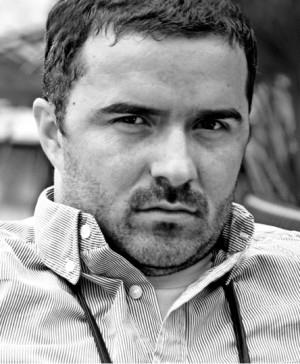 Radenko Milak was born in 1980. In Travnik. He graduated at the Academy of Fine Arts in Banjaluka, painting department. At the Academy of Fine Arts in Belgrade, he graduated on master studies in 2006. At the moment, he is on PhD at the Academy of Fine Arts in Belgrade. Radenko is a director of Center for visual communication Protok and biennale of Contemporary Art SpaPort. As a cultural activist, during 2005., he establishes art association Protok, which acts in Bosnia and Herzegovina, as well as the Balkans. Radenko achieved several awards for his art achievement.
Radenko Milak was born in 1980. In Travnik. He graduated at the Academy of Fine Arts in Banjaluka, painting department. At the Academy of Fine Arts in Belgrade, he graduated on master studies in 2006. At the moment, he is on PhD at the Academy of Fine Arts in Belgrade. Radenko is a director of Center for visual communication Protok and biennale of Contemporary Art SpaPort. As a cultural activist, during 2005., he establishes art association Protok, which acts in Bosnia and Herzegovina, as well as the Balkans. Radenko achieved several awards for his art achievement.
Solo exhibitions:
2006 Sweet ad Rotten Smell of History, gallery ay the Faculty of Arts in Belgrade; 2007 Intimacy of Planetary Event, Museum of Contemporary Art of Republic of Srpska, (Banjaluka); 2011 Estetizacija politike, Gallery UBSM, (Beograd).
Group exhibitions:
2000 – Even the wars have limits, Mak Gallery, (Sarajevo); 2002 – Art, reality, action, International summer art school, Gallery Likovni susret, (Subotica); 2002 – INTERBIFEP, Gallery of world’s portrait, (Tuzla); 2004 – Quo Vadis, Art Gallery of Bosnia and Herzegovina, (Sarajevo); 2004 – Quo Vadis, Museum of contemporary art RS, (Banjaluka); 2006 – Continental Breakfast, Memory (W)hole, Museum of Contemporary Art RS,(Banjaluka); 2006 Eastern neighbors, Cultural Center Babel,(Utreht); 2007 Retrospektrum, National Gallery of BiH, (Sarajevo); 2007 Interspace, Musum of Contemporary Art of Vojvodina, (Novi Sad); 2008 Interspace, Gallery of Cultural Center, (Belgrade); 2008 Interspace, Museum of contemporary art RS, (Banjaluka); 2008 Salon Revolution, Galery HDLU, Zagreb, Croatia; 2009. Umjetnost i terorizam, bosansko-hercegovačka umjetnost poslije 11/9, Gallery Bihać; 2009. Identity, Galerija Erasme Janer, (Barcelona); 2009. Obsession, Ada Street Gallery, (London); 2009. Interspace, Museum of city Skoplje, (Skopje); 2010. Interspace, National Gallery of BiH, (Sarajevo); 2010. Krieg.Kunst.Krise, Hofburg Museum, (Insbruk); 2010. Kultur via Europa, Palace Porti, (Vienna); 2010. Kultur via Europa, Rein, (Graz); 2010. Where Everything Is Yet to Happen (WEIYTH), 2nd chapter: Exposures, SpaPort Biennial, (Banjaluka); 2011. Multiorginal, Museum of Contemporary Art RS, (Banjaluka); 2011. Krieg.Kunst.Krise, Artpoint gallery – KulturKontakt Austria, (Vienna); 2011. Crisis of Illusion, Gallery Fontikus, Grožnjan, (Istra); 2011. Artexchange, Sajam savremene umjetnosti, (Rovinj); 2011. Biennial Time Machine – No Network, Tito’s Bunker, (Konjic).
My art production is exclusively connected to the recent history of the Bosnian society, focusing on the war, and its reflexions on the social everyday life. The war subjects are still the most dominant public discourse, initiated by the political elites. Grand national-irrational subjects have metastases into the only possible idea of the ruling political elite, which manipulates abuses facts in favour of future votes inside their national body. (…)Today we have an impression that the peace is a truce, in fact that the peace is a pause to regenerate new wars. Collective trauma is still produced, reproduced, and the state of artificial peace, which is perpetuated with national hatred has no alternative. Any hope of new generations or new political elites to start a wide, open public debate of all the social problems is gone. The only logical and possible way I see through art, through individual speech, through taking a clear political position with my art, which explicitly opens social and political trauma.
„And what haven’t you seen yet?
I couldn’t have seen everything!“
A series of oil paintings (envisaged as work in progress) has been inspired by an event that happened in the beginning of the war in Bijeljina, when para-military militia called Tigers, led by Zeljko Raznatovic Arkan, entered Bijeljina. On the same day an American photographer Ron Haviv came to Bijeljina, who managed to take photographs of one of the most brutal scenes from the wars in the former Yugoslavia. That scene became a global media event, a matrix for measuring the brutality of the wars in Yugoslavia; those photos have become the top subject for magazines and today the Internet portals.
The title of this series is Ron Haviv’s reply to a journalist’s question «And what haven’t you seen yet? » «I couldn’t have seen everything!»
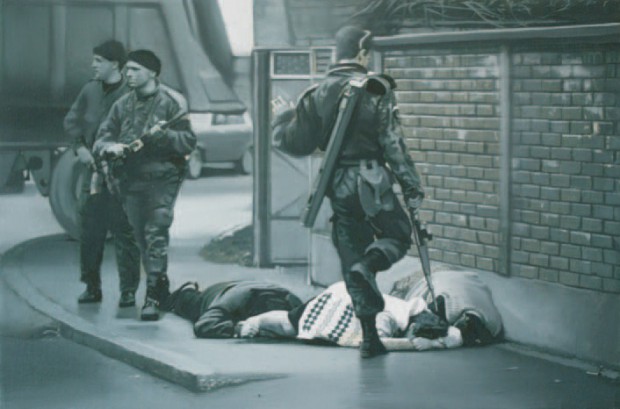
 So.ba – Opening
So.ba – Opening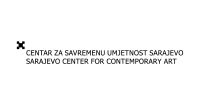 Sarajevo Center for contemporary art (SCCA)
Sarajevo Center for contemporary art (SCCA)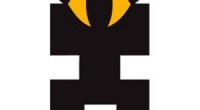 Pro.ba
Pro.ba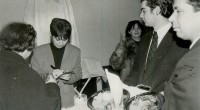 Opening of Soros Center for Contemporary Art Sarajevo
Opening of Soros Center for Contemporary Art Sarajevo